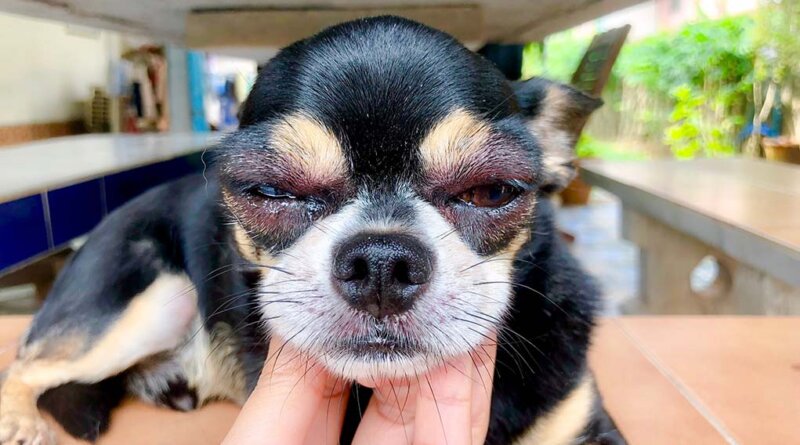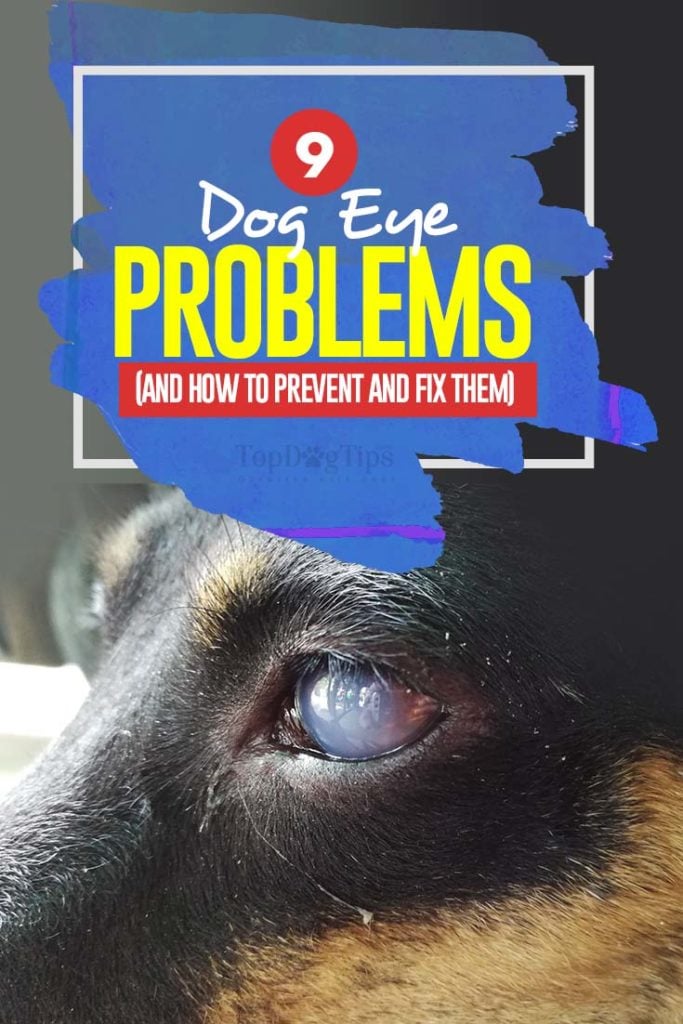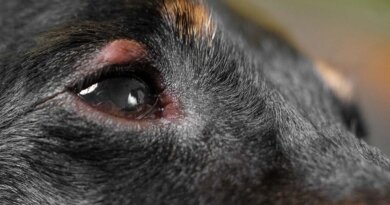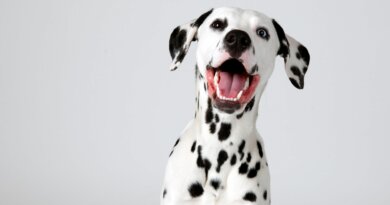9 Dog Eye Problems with Pictures: Causes, Prevention and Treatment
Dog eye problems are very common and in most cases it’s just a mild inconvenience. However, certain conditions will be more serious and require veterinary intervention, including surgery.
Studies observed that German Shepherd Dogs and Maltese are twice more likely to suffer from different types of eye disease than any other breed. Dry eyes, cataracts, corneal ulcers, progressive retinal atrophy and glaucoma are the most common eye conditions in dogs, commonly occurring in breeds between ages of 4 and 7 years old.
Eye disease are often inherited, and it’s the most well-studied areas of all inherited diseases in dogs. Below is a list of nine most common dog eye problems with pictures, their causes, prevention and treatment.
9 Most Common Dog Eye Problems

1. Eye Inflammation
Eye inflammation in dogs is a common occurrence and it’s usually a symptom of some underlying disease. Most often it is a sign of infection in or near the eye, but it can also be caused by allergies, autoimmune disease and injury. In rare cases, it can even be a sign of tumors. Some common symptoms of dog eye inflammation include redness, pain, discharge and squinting.
How to Prevent It:
Since eye inflammation in dogs can be caused by a wide range of things, it is very difficult to prevent it from occurring. However, you can attempt to prevent these infections, particularly fungal and parasitic ones, by keeping your dog’s living conditions sanitary.
How to Treat It:
The treatment will also depend on the underlying condition itself. Usually, it consists of prescribed ointments or eye drops designed for treatment dog eye inflammation and that are applied directly onto the dog’s eye. Additionally, oral medications are often used to reduce the overall inflammation and pain in the dog’s body.
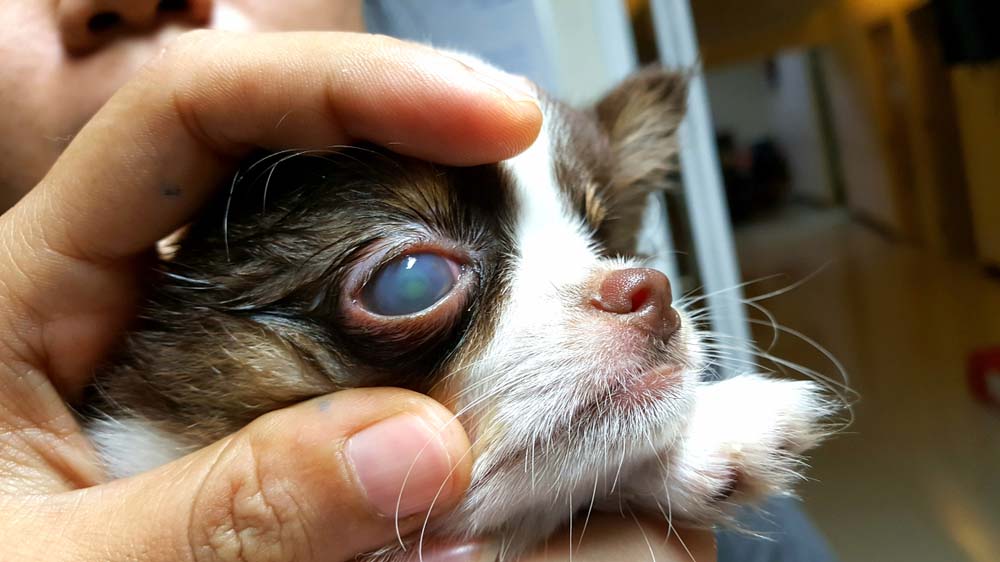
2. Corneal Ulcers
Corneal ulcers are one of the more common dog eye problems but usually aren’t as serious as they may sound. This is a simple surface erosion within the dog’s eyes. They normally occur after an injury by a foreign object but they may also be caused by eyelashes, products, clothing or even dog’s hair that scratched the dog’s eye, bad tear production or high intra-ocular pressure.
Corneal ulcers in dogs are often not easily visible, so look for any surface damage if you notice that your pooch keeps his eye closed or partially closed very often. When you can’t spot them yourself, take your dog to the vet for the proper diagnosis.
How to Prevent It:
The only thing you can do to prevent stealthy dog eye problems like corneal ulcers is to keep your dog away from any possible trauma and injury to the eye. This is especially true if you have a cat, since cats can often cause these ulcers by scratching a dog’s eye.
How to Treat It:
Superficial corneal ulcers in dogs are treated with topical antibiotics or anti-fungal dog eye drops and ointments, in addition to topical medication for the pain (atropine, for example). In some cases, systemic oral non-steroidal anti-inflammatory drugs (NSAIDs) will also be used.
For severe dog eye ulcers, the vet may apply a soft contact lens and an Elizabethan cone to keep the dog’s eyes safe while they heal. In this case, the dog should be kept indoors to avoid bright lights. Regular checkups are also needed for severe cranial ulcers since the treatment can last for multiple weeks.
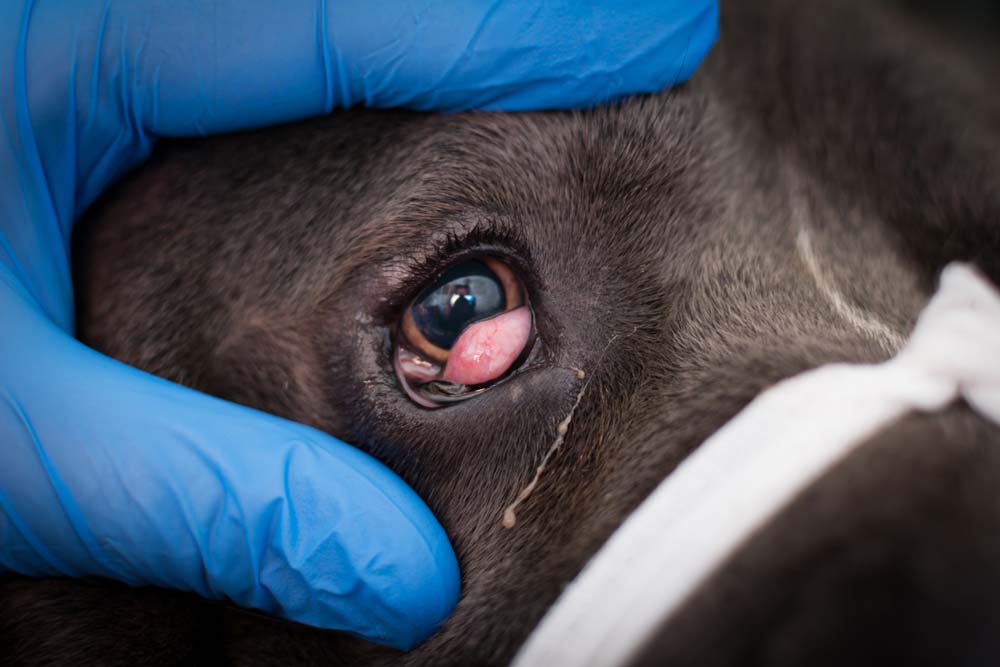
3. Cherry Eye
Dogs have a third eyelid and prolapse of that third eyelid is called cherry eye. This problem is characterized by the swollen mass that occurs near the lower eyelid, which is closest to the dog’s nose. Cherry eye is one of the most common dog eye problems pet owners notice, and it usually occurs in puppies and young dogs, up to two years of age.
How to Prevent It:
Since this illness is mostly genetic, which is obvious because certain breeds like Bulldogs are at bigger risk than others, there isn’t anything you can do to prevent it. Smaller breeds and breeds with shorter muzzles are at a greater risk of suffering from cherry eye.
How to Treat It:
The only safe way to get rid of cherry eye in dogs for good is surgery. Even though there are many accounts of successfully dealing with this problem with a gentle massage of the eyelid with a warm cloth and eye drops, this home treatment is only successful if the condition is diagnosed in the earliest stages, and even then it may come back later. Treating cherry eye with a steroid ointment is another option, but not always effective.
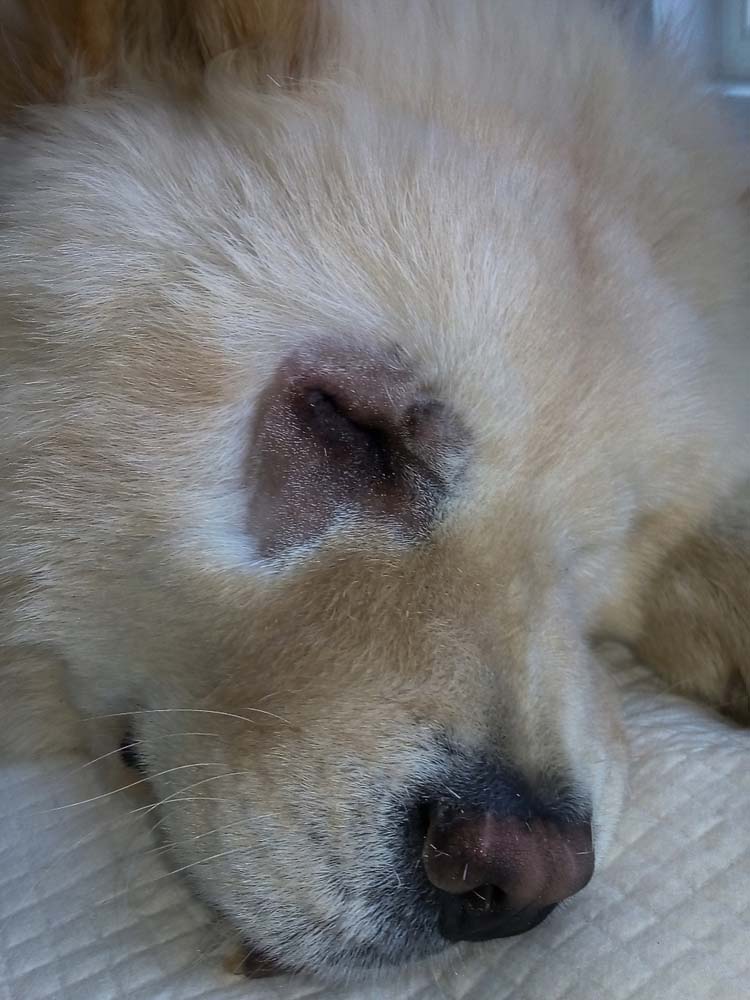
4. In-Grown Eyelids (Entropion/Ectropion)
This is a condition caused usually by genetic factors. Entropion in dogs causes the animal’s eyelids to turn in, which results in pressing the eyelashes against the eye and can lead to dog eye ulcers discussed above. This can be a very painful condition for the dog.
Squinting, watery eyes and keeping eyes closed are the most prominent symptoms of ingrown eyelids in dogs. Entropion is usually diagnosed very early in a pet’s life, mostly before one year of age. Ectropion is a similar condition with a difference of outward rolling of eyelids instead of inward. The treatment is the same as with entropion.
How to Prevent It:
Entropion or Ectropion are not preventable since it is usually a genetic condition.
How to Treat It:
Even though some topical ointments and doggy eye drops can relieve the symptoms caused by in-grown eyelids on dogs, the only long-term solution is a common, low-risk surgical procedure to get rid of this for good.
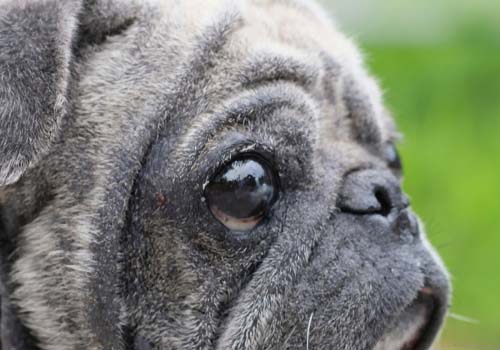
5. Dry Eye Syndrome (KCS)
Dry eye syndrome, or Keratoconjunctivitis sicca (KCS), which is the right medical term, is one of the more common dog eye problems in which dog’s tear glands don’t produce enough tears. That can lead to many more serious complications, like corneal ulcers, pain and chronic mucus drainage from the dog’s eyes.
Dry eye syndrome in dogs is mostly caused by autoimmune disorders, but it can also be caused by middle ear infection, trauma, damage to the facial nerve, viral or bacterial eye infections. It can also be a result of cherry eye surgery and the removal of the third eyelid. Some of the symptoms include red eyes, pain, squinting and discharge of mucus.
How to Prevent It:
There is no way to prevent dry eye in dogs that is caused by autoimmune disorders. However, you can prevent other potential causes, like trauma to the eye or ear infection by keeping the ear canals clean.
How to Treat It:
Most cases of dog dry eye are treated by topical medications, like the artificial-tear medication. A lubricant is also prescribed sometimes. It is important to keep your dog’s eyes clean before you use any of the medications. Also, in recent years there have been advancements in treatment of dry eyes in dogs, and parotid duct transposition (PDT) surgery was shown in a 2009 study to have some great results.

6. Conjunctivitis (Pink Eye)
This is a name for inflammation of the conjunctiva, which are the mucous membranes that serve as a cover for dog’s eyelids, and it’s also one of the more common dog eye problems that pet owners easily notice. Pain and discomfort, as well as swollen and reddened conjunctiva and discharge, are the usual symptoms of conjunctivitis in dogs.
Conjunctivitis is always a symptom of some underlying issue, typically one of the other mentioned dog eye problems above, like infections, allergies and inward growing eyelashes.
How to Prevent It:
A 2009 AVMA study shows that contact with other dogs is the biggest risk factor, so ensure that your pooch doesn’t come in contact with dogs that may have conjunctivitis. Free-roaming dogs are most likely to contract viruses that cause conjunctivitis. Also, some studies showed that neutering/spaying can help with prevention.
How to Treat It:
Treatment for conjunctivitis in dogs will depend on the underlying cause. For some basic treatment, you can use sterile saline eye washes to clear the dog’s eye and flush irritants. However, it is very important to get the right diagnosis for the underlying cause, so take your dog to your vet to get the right assessment and treatment.

7. Cataracts
Cataracts on dogs is the most well-known among dog eye problems. Cataract is a name for a cloudy or opaque lens, which is located in the center of the dog’s eye and it is usually clear. The cataract blocks light and prevents it from reaching the back of the eye.
For dogs with cataracts, this leads to poor vision or even blindness. The most important symptom of cataracts are white or grey pupils. Cataracts can occur due to genetic reasons, but they are also caused by diabetes, infection or eye injury among other mentioned dog eye problems above. A condition called lenticular sclerosis is similar to cataracts but it is different and caused by aging.
How to Prevent It:
Other than prevention in similar ways as other mentioned dog eye problems, nutritional deficiency can also sometimes cause cataracts in dogs. Making sure that your dog has a healthy and well-balanced nutritional diet is essential. Regular vet checkups are important for early detection.
How to Treat It:
Treating the underlying cause of cataracts is the first treatment option when that is possible. Surgical removal of cataracts is often the way to go if the dog is otherwise healthy. However, surgery is only recommended if the dog’s vision is severely compromised. In minor cases, dogs can get used to dealing with poor vision.

8. Glaucoma
Glaucoma is a condition that disrupts the balance of production and drainage of fluid in the eyes and increases the eye pressure. Pain, increased tear production, eye redness, corneal cloudiness and dilated pupils are the most common symptoms of glaucoma in dogs. In severe cases, the eye will become obviously enlarged. Primary glaucoma is genetic, while secondary glaucoma is caused by infection or injury. It’s one of the most serious dog eye problems, and if left untreated, glaucoma can lead to blindness.
How to Prevent It:
Providing your dog with enough antioxidants like vitamins E and vitamin C, vitamin A (beta-carotene), lutein and others can promote the dog’s general eye health and decrease damage in case of an injury or infection. Avoid tight collars since studies show they can increase intraocular pressure. Get regular eye examinations for early detection.
How to Treat It:
In severe cases of glaucoma in dogs, surgery is often the best and only option. Otherwise, glaucoma is usually treated by a mix of topical and oral medications, similarly to the other above mentioned dog eye problems.
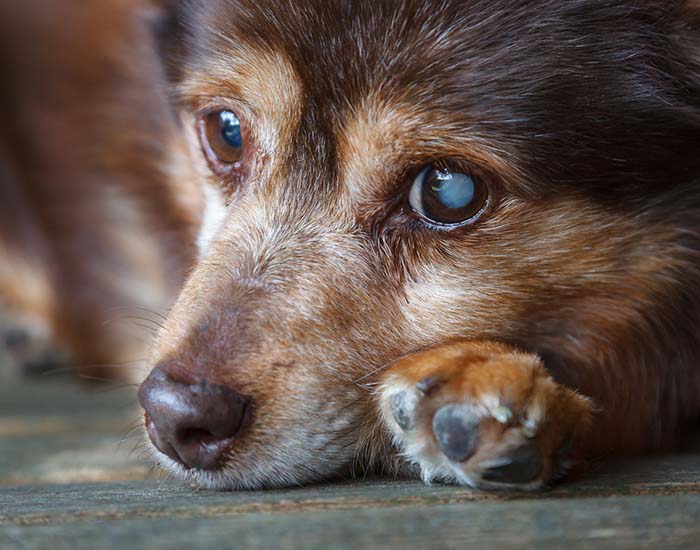
9. Progressive Retinal Atrophy (PRA)
Progressive Retinal Atrophy (PRA) is a very serious eye condition in dogs that gradually leads to blindness. The lack of symptoms until the condition becomes obvious makes it one of the hardest to spot dog eye problems.
Usually, the first symptom of PRA in dogs is night blindness and after that comes the poor vision overall. If you notice that your pup is often tripping over things, bumping into furniture or walls and generally displays signs of poor vision, PRA could be the culprit.
How to Prevent It:
Progressive retinal atrophy in dogs is a genetic disorder and there is no way to prevent it. Responsible breeding, spaying or neutering of dogs at the right age that carry the PRA gene, is the only way to fight this condition, especially since in some breeds, dogs that got the gene from only one parent won’t develop the condition.
How to Treat It:
At the moment there is no effective treatment available for PRA in dogs. Management of the condition is the only available option for pet owners. The condition itself is painless, so dogs usually adapt well to going blind.
Most of these common dog eye problems mentioned above are easily treatable. However, early detection and proper diagnosis are very important, so analyze these dog eye problems pictures, recognize in time for treatment.
Take your dog to the vet for regular checkups and as soon as you notice some of the symptoms of eye problems. Do your own check-ups of your pup’s eyes when grooming or after injuries and accidents.
READ NEXT: 7 Most Serious Eye Problems in Dogs and How to Deal With Them

